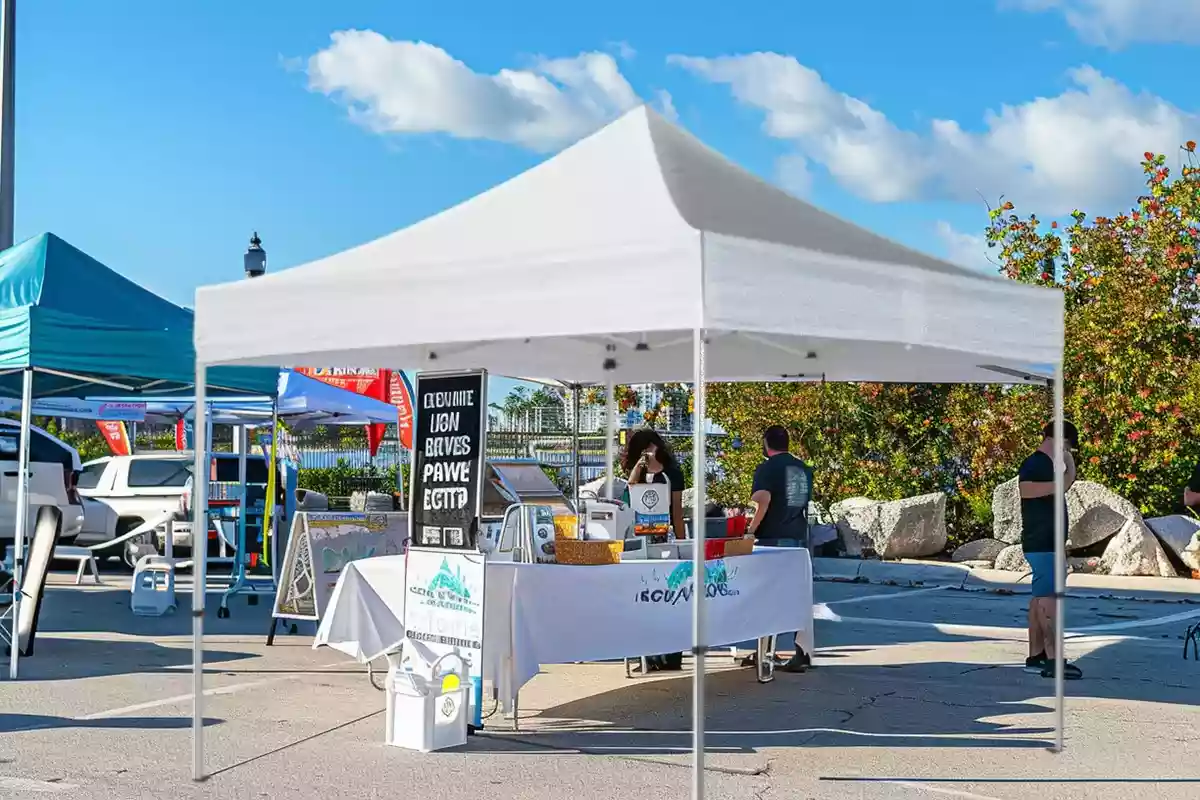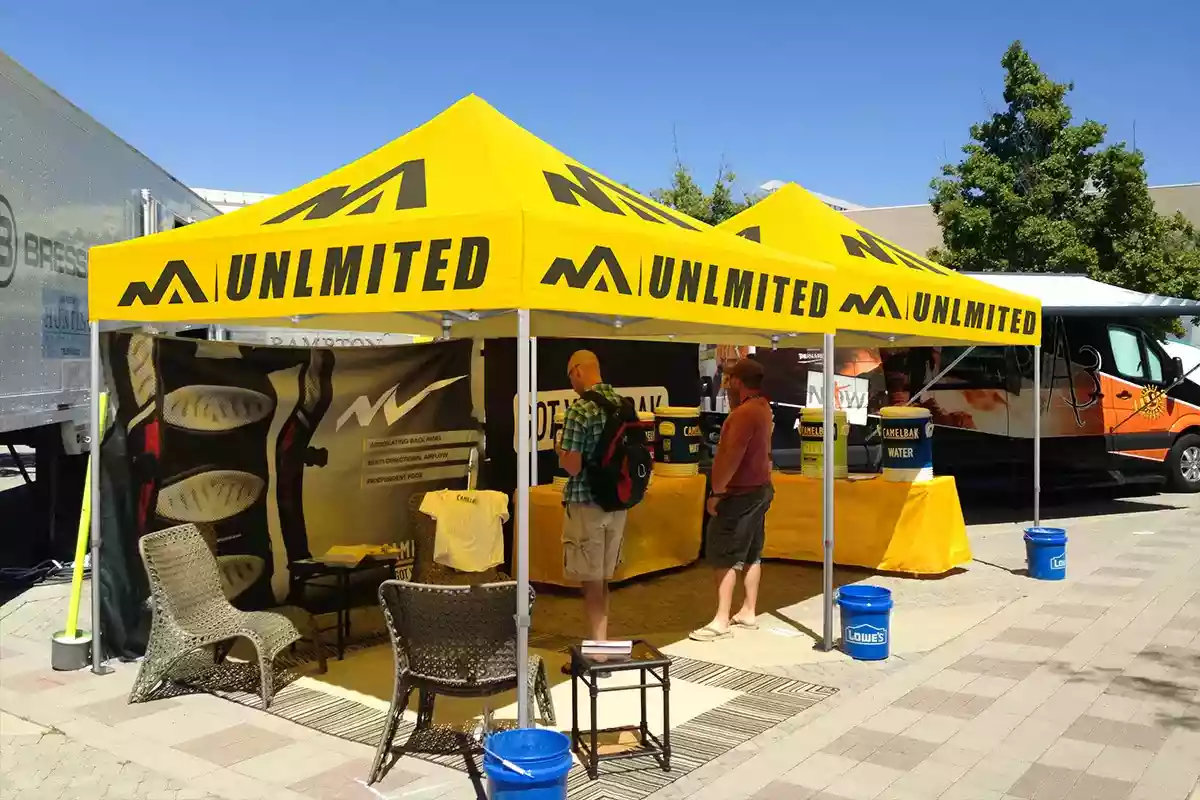
Most of the time, canopy tents work well against the forces of nature. They are reliable shelters, easily providing shade from the sun and keeping you dry from the rain. Their primary weakness, however, is wind. Even the most durable pop up canopies can struggle in strong gusts. While many modern designs are built to handle breezes, they still need some assistance to ensure they don’t blow away.
If you don’t know how to keep a pop-up tent grounded on windy days, then we’re here to help. We’ve put together crucial purchasing advice and robust strategies for securing your investment against adverse weather.
Buy One Made of Sturdy Materials
Before diving into how to secure your canopy, it’s important to start with the tent itself, specifically, its materials. Some of the more common fabric types used for the canopy are polyester, nylon, vinyl, and canvas. While these vary in terms of their benefits, they should all hold up against fierce winds if they’re thick enough. However, if you want the strongest option, go with high-denier polyester.
As for the canopy tent frame, steel and aluminum are both excellent options. Both materials do not bend or break in intense winds. Steel is usually heavier and offers excellent stability in rough conditions. Aluminum is lighter and easier to transport. If you’re looking for reliable wind resistance without the extra weight, a heavy duty aluminum frame is a great option.
Pick a Larger Tent if Possible
When factoring in the wind, many people think a smaller canopy might be the better option since it will catch less of the breeze. While there’s some truth to that, larger tents tend to stay grounded more easily due to their added weight. They require more poles and structural supports, which increases overall stability and helps them better withstand strong winds.
If you decide to go with one of Westshade’s customized canopy tent, you’ll be able to choose from a wide range of sizes. On top of being able to customize the colors and pictures on the canopy, you can also choose a larger frame size to combat the wind more effectively. Explore our canopy tent series.
Find a Safe Spot for It
Once you’ve purchased your tent and are ready to set it up on a windy day, the first step is to find a safe location. Just because it’s gusty doesn’t mean the wind is equally strong everywhere in your setup area.
If there’s a grove of trees or some tall buildings nearby, they will break the wind for you. You’ll still experience some breezes, but they won’t be as extreme as they would be if you were in the middle of an open space.
Assemble It Correctly
Once you find a spot, make sure you can set up the canopy correctly. Most canopy tents have quite a few joints you need to connect. If you don’t hear a loud click when snapping these pieces into place, the chance of the tent collapsing during the next strong gust of wind rises drastically. Also, make sure you tightly fasten all the hook-and-loop straps on the canopy. Failing to do so might cause the top to blow away without the frame, which will be much harder to catch.
Anchor It Down
Fortunately, most pop-up tents come with ropes and stakes that allow you to anchor them tightly to the ground. These will be the best option for ensuring that your tent stays grounded on those windy days. Start by attaching the ropes to each of the four corners of the frame. If you have a larger tent, you can also put a few on the edges.
Once you hook those on, tie the other end to the stakes. After you’ve secured the attachments, it’s time to hammer them into the ground. Make sure you do this at a length that keeps the rope taut. Some frames also have holes at the base of each leg specifically for stakes. Be sure to also utilize those designated openings when they’re available.
Add Some Weight to It
If the stakes aren’t enough, add some weight to the base of the frame for extra support. You can purchase weights that fit perfectly around the legs of a pop-up tent. However, sandbags or any other heavy bag can do the trick if you don’t have tent weights on hand.
Fortunately, every tent from Westshade comes with free sandbags, so you won’t need to spend extra on on additional weights.
Strategically Use Sidewalls

Some people recommend removing sidewalls when the wind picks up. In certain cases, that’s a smart move. But when used strategically, canopy sidewalls can improve your tent’s stability.
The main issue with wind is that it often gets underneath the canopy, creating lift. By placing a sidewall on the wind-facing side of your tent, you can block gusts from getting underneath and reduce that lifting force.
That said, sidewalls aren’t always the perfect solution. If the wind shifts direction frequently or becomes too strong, enclosed walls can trap pressure and cause instability. But in mild, steady conditions, a well-placed sidewall can be an effective way to keep your tent grounded.
Take the Tent Down
No matter how well you’ve secured your tent, there comes a point when it’s safer to take it down. If wind speeds become too high, typically above 25–30 mph, even the strongest canopy can become unstable or damaged.
Always monitor weather conditions throughout the day, and don’t hesitate to pack up early if gusts grow too intense. It’s better to take a short break or end the day early than risk injury or equipment damage.
Conclusion
Windy conditions don’t have to ruin your outdoor setup. With the right tent materials, smart placement, proper anchoring, and a few strategic adjustments, you can keep your canopy stable and secure.
Whether you’re setting up at a farmers’ market, a sporting event, or a weekend festival, preparation is key. Always keep an eye on the weather, and don’t be afraid to take your tent down if conditions become unsafe.
With the right approach, your pop-up tent can stand strong, even when the wind picks up. If harsh weather is a concern, Westshade canopy tents are made to stay put, even when the wind picks up. Explore our durable tents and wind-ready accessories.








